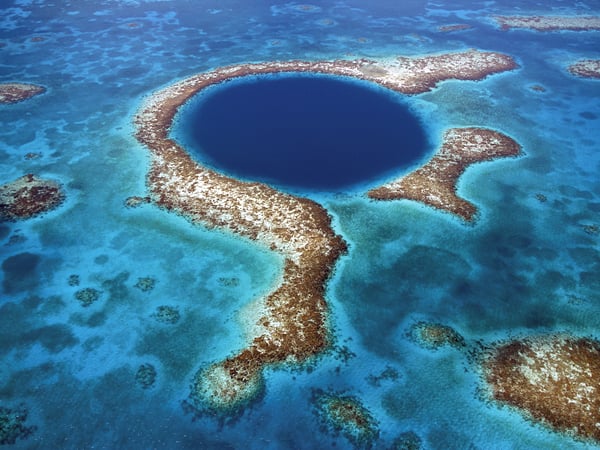

 |

|

|
|
The second largest barrier reef in the world rises from the seafloor off the coast of Belize. A diver's paradise, it is known for fascinating coral formations, myriad fish and invertebrates, and exceptional water clarity. On the ocean side of this 160-mile-long reef is a popular tourist designation known as Lighthouse Reef. Here, crystal-clear waters fill the famous Blue Hole, a crater more than 1,000 feet across and just over 400 feet deep. At the surface, healthy coral formations rim this wonder within a wonder, but at a depth of 125 feet, neither corals nor fish can be found. Instead, a diver finds stalactites formed during the Ice Age, when the world sea level was much lower and the Blue Hole was a subterranean cavern. The hole formed when the cavern's roof collapsed. To the south is Glover's Reef, surrounded by waters so clear that visibility even at night is quite good: The long shaft of a diver's torch can pierce the water to a distance of 15 feet. Because it is several miles from the mainland, this reef is not affected by silt and sediment runoff. At Glover's, the arrival of a diver startles bright red cardinalfish swimming in open water, they rely on organs called lateral lines running along both sides of their bodies. A combination of sonar and radar, a lateral line senses vibrations and movements in the water, allowing fish to detect predators and pray. It's also an early warning device. As a fish swims, it creates a sort of bow wake that bounces off solid objects. When another fish feels the wake, it moves to avoid a collision. Glover's Reef is home to the Emerald Forest, a site named for magnificent elk horn coral "trees" having trunks a foot diameter and canopies more than ten feet high. Several kinds of exotic fish also live here, and at night, a camera-bearing diver can catch them asleep, tucked in against the reef, but still out in the open. Butterflyfish as colourful as backyard butterflies hover in the water. So do hogfish with pig like snouts, trumpetfish that look like two-foot-long musical instruments, and parrotfish, their beaklike mouths closed for the night. Not all of the reef's creatures are lost in sleep, however. Manta rays and sharks prowl the darkness, seeking meals. Lobsters, crabs, shrimp, and nudibranchs (the beautiful slugs of the sea) search the reef for food and mates. A Nassau grouper gets its mouth "cleaned" by a tiny shrimp, which darts from side to side and from top to bottom to remove small parasites and dead flesh from the cooperative fish, its mouth frozen in a wide yawn. The shrimp gets a free meal, so to speak. Dr. Mary Wicksten, a marine biologist at Texas A&M University and a specialist in these so-called cleaning stations, says that fish seek out established stations on the reef because the activity is important for their health. Like several other reef fish, the Nassau grouper is remarkable for its ability to change sex as it gets older, increasing its chances for reproductive success when another grouper is met. At a natural cut in Glover's Reef, where water surges during the changing of the tide, a diver can free-fall horizontally, whipped along by the strong current. But fish hover without obvious effort, their streamlined bodies designed by nature to keep them in place in such conditions. Jutting from the walls of the cut, like fingers on a huge hand, are lavender tube sponges that eat by filtering tiny plants and animals from the sea. Soft coral sea fans, also filter feeders, bend in the breeze like underwater current that brings them a constant supply of food. The dominant life-form here is the hard coral, which is capable of withstanding the force of very strong wave action. Where the current exits this canyon, it stirs up sand from the floor of a lagoon, reducing visibility. Somewhere near the bottom, turtles and manatees leisurely feed on sea grasses, while small coral heads form mini-reefs alive with tiny fish. Across the lagoon is the Hol Chan Marine Reserve, a small area off Ambergris Cay where the tangled roots of a mangrove forest reach into the water. Even here, small fish dart among the roots, looking for meals or protection from predators. Hol Chan, which is Maya for "the cut," was established in 1987. It encompasses all three habitats of the barrier reef ecosystem: reef, lagoon, and mangroves. Although separate, each area depends on the others. Marine scientist Jacque Carter, who has long studied Belize's fish, writes: "The mangroves are a feeding and breeding ground for reef fishes; they also trap silt and sediment runoff before it reaches the reef. The lagoon is...a feeding ground for many reef fishes, and the sea grasses...trap reef-smothering particles [keeping them] from reaching the lagoon, mangroves and shore areas from destructive wave action. If one area is damaged, the others are also affected - which is why it is important to protect the entire system, and not just the beautiful coral reef."
|
CAN'T FIND WHAT YOU'RE LOOKING FOR? CLICK HERE!!!